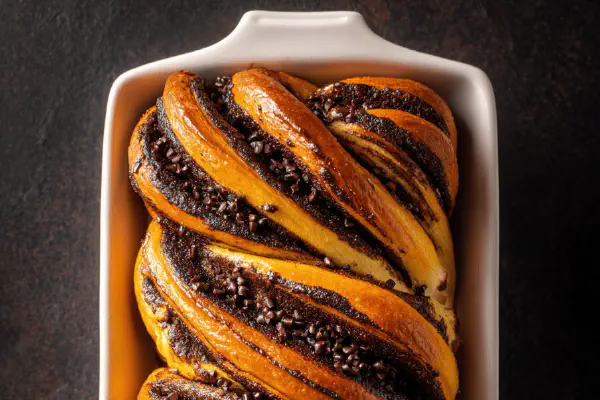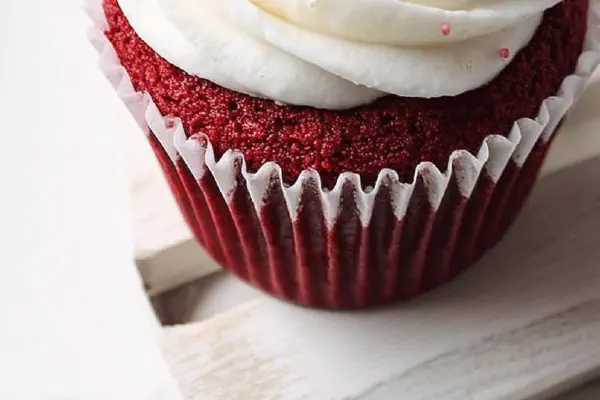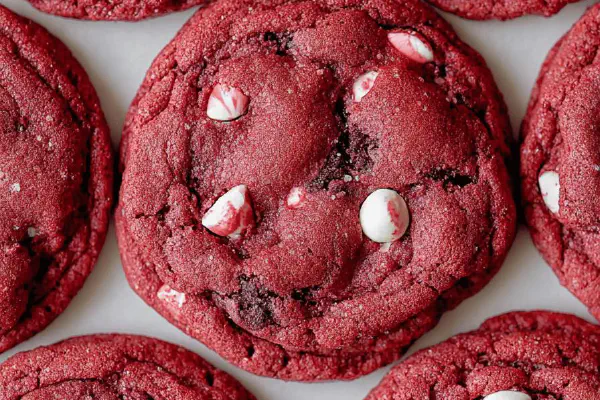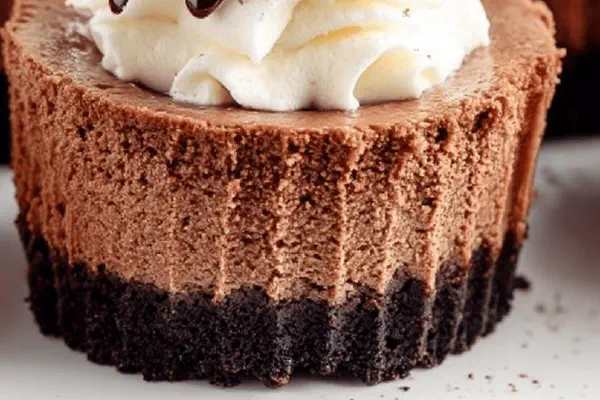Mini Chocolate Surprise Cupcakes
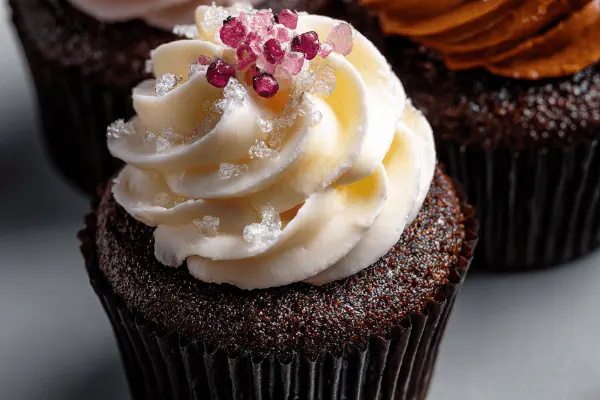
By Emma
Certified Culinary Professional
Ingredients
- 180 ml (¾ cup) all-purpose flour, unbleached
- 2 ml (½ tsp) baking soda
- 1 ml (¼ tsp) salt
- 180 ml (¾ cup) milk
- 120 ml (½ cup) unsweetened cocoa powder, sifted
- 60 ml (¼ cup) melted coconut oil
- 60 ml (¼ cup) unsalted butter
- 50 g (1¾ oz) dried currants
- 2 large eggs
- 200 ml (¾ cup plus 1 tbsp) maple sugar
- 1 tsp instant espresso powder, optional
Swiss Meringue Buttercream
- 250 ml (1 cup) sugar
- 2 egg whites
- 375 ml (1½ cups) unsalted butter, room temperature
- 3 drops natural beet juice (red color), about
- 3 drops spirulina powder mixed in water (greenish tint), about
- 5 ml (1 tsp) pure vanilla extract
- 5 ml (1 tsp) orange zest, finely grated
About the ingredients
Method
Cupcake Batter
- Sift flour, baking soda, salt together into bowl. Set aside. In a small pot, warm milk but don’t boil. Whisk cocoa powder into milk till smooth with no lumps. Add melted coconut oil and butter, stir till fully blended. The butter should melt in but not scald milk; keep temperature low to avoid graininess. Stir in espresso powder if using. Let cool until lukewarm. Meanwhile, beat eggs and maple sugar with electric mixer until light, fluffy, about 4 minutes; sugar must dissolve to avoid gritty crumbs. At slow speed, alternate adding cocoa mixture in thin streams and dry ingredients. Fold gently but thoroughly. Fold in currants quickly so they stay whole and don’t bleed. Cover batter and chill for 25 minutes—this step tightens crumb and prevents cupcakes from doming too high and cracking in oven.
- Arrange oven rack middle level. Preheat oven to 175°C (350°F). Line muffin trays (28 slots) with 60 ml paper cups. Ladle 30 ml batter in each cup, about two tablespoons. Best not to overfill to avoid runny tops. Bake 18-20 minutes. After 15 minutes, watch domes rise. When edges pull slightly away from cups and a tester tooth picks crumbs, the cupcakes are done. Pulling out too early or too late yields gummy or dry results. Cool on wire rack completely before filling.
Swiss Meringue Buttercream
- In a clean metal or glass bowl over simmering water (bain-marie), whisk sugar and egg whites constantly. Don't let mixture go above 60°C—for thickening and pasteurization without scrambling whites. Heat until all sugar granules dissolve; test between fingers, no graininess. Remove bowl. Switch to electric mixer, whip whites into stiff, glossy peaks, about 12-15 minutes. The meringue should be cool before butter addition, else butter melts and cream separates.
- Add butter cubes gradually; mix thoroughly after each addition. Texture will look broken, grainy—don’t panic. Keep beating on medium-high till creamy and smooth, ribbons form and no fat streaks remain. Separate 180 ml of buttercream, stir in beet juice for red shade; leave rest plain and stir in vanilla and orange zest for subtle taste lift. Keep both covered until use to prevent drying.
Filling and Assembly
- Use small paring knife to cut a shallow cross at cupcake center, about 1.5 cm wide, just deep enough to pierce crumb without cracking outside. With a piping bag fitted with a narrow round tip (approx 0.5 cm), inject about 5 ml red-tinted buttercream into each hole smoothly. Filling needs to be firm but soft to pipe, not runny. Top cupcakes by piping vanilla buttercream with a larger round or star tip, in swirls or dollops. Sprinkle a few flakes of flaky sea salt on top for texture contrast and to amplify chocolate notes.
- Store cupcakes in cool place but not refrigerator to avoid buttercream hardening too firm. If fridge needed, take out 15-20 minutes before serving for optimal texture.
Troubleshooting & Tips
- If buttercream separates, chill bowl briefly and remix. For currants, soak in hot rum or coffee briefly to plump if dry. Coconut oil can solidify at room temp making batter lumpy; gently rewarm but don’t cook. To test doneness beyond timer, watch color shift to matte and edges pulling. No toothpick? Gently press top for bounce—springs back is done.
- Experiment with swapping maple sugar for coconut sugar if maple flavor undesirable; expect darker crumb. Orange zest is a subtle lift, but can swap with lemon if preferred. Frozen currants can work but pat dry before mixing.
- Always beat eggs and sugar till fluff to avoid flat cupcakes. Overmix dry ingredients and batter will be tough.
- Use thermometers if you want precision in meringue stage but watch for graininess; tactile testing is reliable. For piping, keep buttercream at room temp, too cold won’t pipe easily, too warm melts.
- These cupcakes hold well for up to 3 days in airtight container. Flavors meld, filling surprise stands out. A small batch tester cupcake baked alone helps for visual cues before baking entire tray.
Cooking tips
Chef's notes
- 💡 Rest batter chilled. Tightens crumb. Cuts doming and cracking. Cupcake domes rise smooth, no fissures. Avoids dry texture. Fold currants last, quick to keep whole. Temper milk warm not hot; scalding breaks fats. Keep butter low temp adding to wet mix; gritty batter ruins cupcakes.
- 💡 Swiss meringue needs constant whisking above simmer, never above sixty degrees Celsius. Dissolve sugar fully, test fingers. Shift to mixer fast; whip fifteen minutes for stiff peaks. Butter addition slow but steady. Broken cream phase ok, keep beating, texture will fix. When ribbons form, stop. Divide cream; beet juice for red. Rest plain with vanilla-infusion.
- 💡 Cupcake baking cues—you’ll hear batter quiet in oven. Edges pulling from paper liners means almost done. Color dims matte before color browning. Toothpick test stronger after fifteen minutes. Open door too early sinks dome. Ladle batter no more than half full. Too much means collapse or runny tops. Cutting small cross in dome, one and a half centimeters, just pierce crumb.
- 💡 Currants soak quick in rum or coffee before folding in to plump. Makes tart bursts juicier, stops dry fruit. Coconut oil solidifies room temp makes lumps, rewarm gently not cook. Espresso powder optional but deepens cocoa notes. Maple sugar over brown means less moisture, more bite. Can swap coconut sugar expect darker crumb.
- 💡 Buttercream piping needs room temp. Too cold, won’t pipe smooth; too warm melts fast. Use narrow round tip for filling, about half centimeter. Inject filling gently, five ml per cupcake. Top with star or round tip vanilla buttercream. Sprinkle flaky sea salt for crunch, contrast texture, enhance dark flavors layered inside.
Common questions
How to keep cupcakes moist?
Batter resting key; chill after fold. Avoid overmix. Coconut oil adds moisture with subtle aroma. Maple sugar instead brown, less damp. Watch oven timing; no early pulls.
Buttercream separates, fix?
Chill bowl quickly, remix on medium speed. If too cold, won’t blend; too warm, breaks. Patience. Add butter slow. If fails, restart with fresh butter white peaks optional. Adding butter too fast a cause.
Substitute ingredients?
Maple sugar swap coconut or light brown sugar but color changes. Currants fresh soaked in rum or coffee replace dry for plumper, juicier pockets. Cocoa powder unsweetened is must; espresso optional but amplifies cocoa depth.
Best storage tips?
Room temp airtight container up to three days. Refrigerate only if hot kitchen but bring back to room temp 15-20 minutes before serving or buttercream hardens. Freeze not recommended buttercream loses texture.
